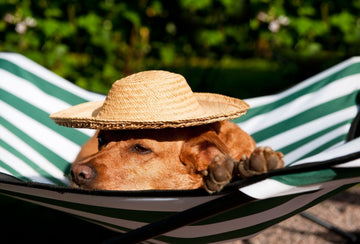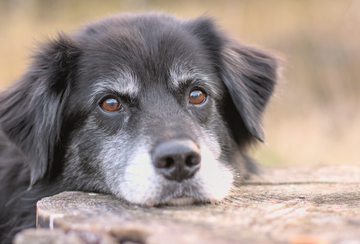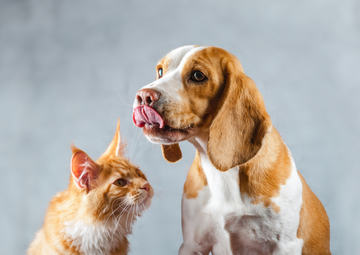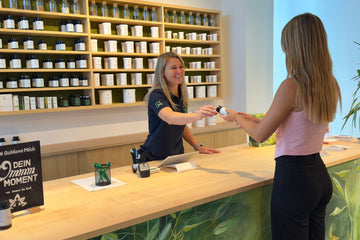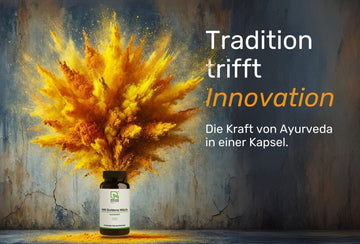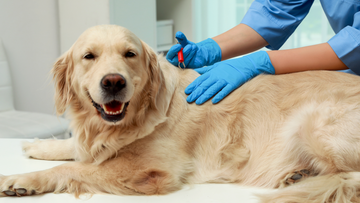Summer is here, the sun is shining—and of course, you're spending more time outside with your dog, cat, or horse. But as wonderful as the warm season is, it also poses risks that are often underestimated: intense UV radiation can cause skin problems in animals. Sunburn is not uncommon—especially on sensitive areas of the body. In this article, you'll learn why proper sun protection is important for animals, which animals are particularly at risk, how you can prevent sunburn, and how a targeted supply of micronutrients strengthens your pet's skin from within.
Can animals get sunburned? The answer is yes!
Even though many animals have thick fur, which at first glance appears to be a natural sunscreen, this does not mean that they are safe from UV rays. In fact, sunlight can penetrate deeper into the skin layers than one would expect – especially if the fur is very short, thin or sparse in patches. Areas of skin with little or no hair are particularly at risk. In dogs, this includes the nose, ears, underside of the stomach or inner thighs. In cats, it is often the ear and eyelid area, especially in light-colored or white animals. Horses are also affected – here the nostrils, corners of the mouth or saddle area are often affected, especially in horses with pink skin or light markings.
Sunburn manifests in animals very similarly to its symptoms in humans: The affected areas of skin become red, warm, sensitive, and begin to flake. As the condition progresses, the skin may peel, crust, and sometimes even ooze or blister. Many animals also exhibit unusual behavior—they lick or scratch themselves more frequently, avoid touch, or appear to be in pain when moving.
Typical symptoms of sunburn in animals are:
- reddened or flaky skin
- sensitive areas
- Crust formation
- Itching or increased licking
- In severe cases: blistering or weeping skin
It becomes particularly critical when the skin is regularly exposed to the sun and becomes repeatedly inflamed. In such cases, as in humans, the risk of light-induced skin changes or even skin cancer can increase. This particularly affects animals with light, non-pigmented skin, as their natural UV protection is significantly lower. Animals with existing skin problems or a weakened immune system are also significantly more susceptible to UV damage.
These animals are particularly vulnerable
Not all animals are equally sensitive to sunlight. Those particularly at risk include:
- Dogs with short or thin fur (e.g. Dalmatians, Boxers, Whippets)
- Cats with white or light fur – especially outdoor cats
- Horses with pink skin areas, e.g. on the nostrils or with piebaldness
- Animals with skin problems, eczema or scars
- Older animals or those with weakened immune systems
Especially with these animals, you should ensure comprehensive protection – both externally and internally.
How to protect your pet from UV radiation
A few simple but effective measures can help prevent sunburn in your pet:
- Create shade: Make sure your animal has access to a shady spot at all times – in the garden, in the stable, or while out for a walk.
- Avoid midday sun: UV radiation is strongest between 11 a.m. and 4 p.m. It's better to schedule walks in the morning or evening.
- UV clothing & protective masks: There are special UV shirts for dogs, and fly rugs and face masks with integrated sun protection for horses.
Sunscreens are also often used – but be careful: Please do not use sunscreen for people or children.
As skin-friendly as children's sunscreen may seem, it often contains substances like zinc oxide or titanium dioxide, which can cause irritation or even poisoning if a dog or cat licks it. Cats are particularly sensitive because their livers are less able to break down certain substances. Therefore, only use sunscreen products suitable for animals, specifically developed for sensitive skin and veterinarian-approved.
Skin protection starts from the inside
When we think of skin protection, we often think of external measures – shade, creams, textiles. But just as with humans, true resistance to environmental stimuli comes not only from the outside, but primarily from within. The skin is one of your pet's largest organs and fulfills countless functions: It protects against germs, regulates the
Body temperature, produces sebum and forms a barrier against environmental influences – including UV radiation.
To achieve all this, it relies on a stable supply of micronutrients. Especially during periods of increased stress—such as in summer, during shedding, or after illness—the need for certain vitamins, minerals, and fatty acids increases significantly.
A balanced skin metabolism is based, for example, on:
- Biotin, which promotes cell regeneration and stabilizes skin structure
- Zinc, which has anti-inflammatory effects and supports regeneration
- Vitamins C and E, which act as antioxidants to capture free radicals
- Omega-3 fatty acids that regulate the skin's moisture balance
Well-nourished skin regenerates faster, remains elastic, and is better able to ward off external stimuli. This not only reduces the risk of skin irritation and flaking, but also better protects against sunburn and light-induced stress.
With high-quality supplementary feed, you can target areas where external measures are no longer sufficient – and offer your animal the protection it deserves from within.
ov-DERMA Dog® – Skin care from within for your dog
A healthy, shiny coat is more than just beautiful—it's a sign of good internal nutrition. ov-DERMA Dog® was specially developed to specifically support your dog's skin and coat metabolism—for example, during shedding, after illness, or simply in the summer when skin and coat are particularly stressed.
Included are:
- Biotin, zinc and B vitamins that promote normal skin and coat structure
- Vitamins C and E to protect cells from oxidative stress
- Omega-3 fatty acids from linseed and evening primrose oil for healthy sebum production
- Cat's claw, neem and black cumin as bioactive plant substances
- as well as papaya and L-carnitine, which complement cellular metabolism
This is how you strengthen your dog's skin from within – for greater resistance to sun, stress and environmental factors.
ov-DERMA Cat® – For healthy skin and a smooth coat
Cats also benefit from targeted support for skin and coat issues. Especially in outdoor cats or during shedding, skin can quickly become irritated. ov-DERMA Cat® provides precisely the nutrients your cat needs during this time:
- Biotin and zinc to support skin function
- Vitamins C and E as antioxidant protective substances
- Evening primrose oil, algae, cinnamon and papaya to strengthen the skin barrier
- Plasma protein and flaxseed to promote nutrient absorption and cell regeneration
The result: smooth, resilient skin and a shiny, healthy coat.
IMUN Horse® Skin – When horse skin needs more
Horses are particularly exposed to the elements – wind, dust, sun, and insects place daily demands on their skin and coat. IMUN Horse® Skin was developed to meet precisely these challenges. The combination of natural fatty acids, vitamins, minerals, and antioxidants provides targeted support from within:
- Omega-3 fatty acids from flaxseed and algae
- Spirulina, seaweed flour and brewer's yeast for a comprehensive supply of micronutrients
- MSM, zinc, copper and biotin for a stable skin barrier
Ideal for use during coat change, for skin problems or for prevention in the summer months.
Conclusion: UV protection for animals is mandatory – inside and out
Our animals depend on protection in the summer just as much as we do. While you provide external safety with shade, protective clothing, and animal-friendly products, a balanced supply of nutrients strengthens skin health from within. Supplemental feeds such as ov-DERMA Dog®, ov-DERMA Cat®, and IMUN Horse® Skin make a valuable contribution to keeping your animal's skin and coat resilient, supple, and radiant.
Because skin care doesn’t start with sunburn – but long before that, in the food bowl.


